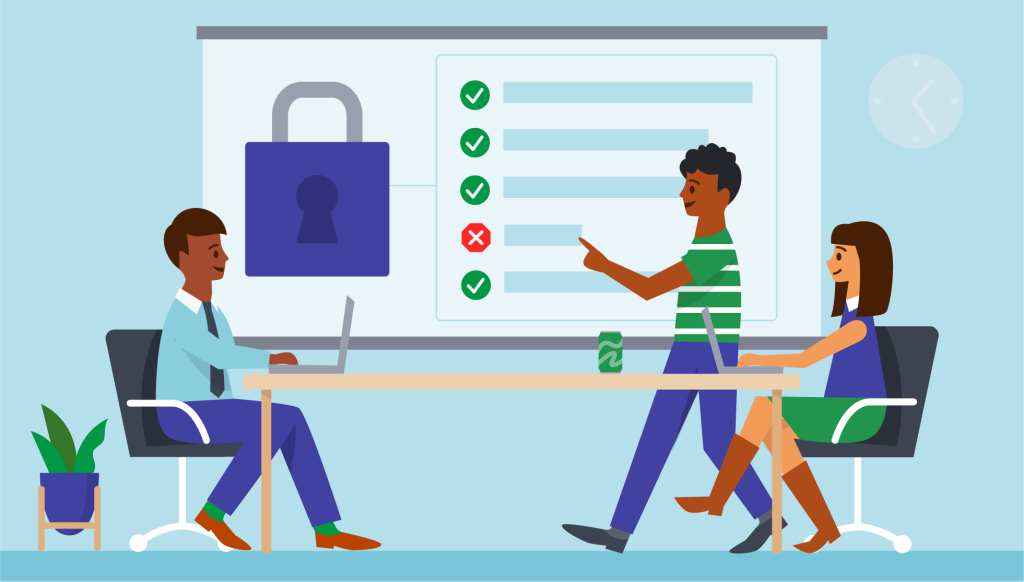Understanding Workplace Security The Ultimate Guide

What is Workplace Security?
Workplace security is the combination of strategies, policies, and technologies that companies implement to safeguard employees, assets, information, and physical premises from threats or harm. It involves a layered approach that encompasses physical security like surveillance cameras and locks, digital security such as firewalls and antivirus systems, and procedural measures like employee conduct rules and access restrictions.
Security in the workplace is not just about stopping a masked intruder or a hacker from infiltrating the network. It’s about creating an environment where employees feel safe, protected, and confident enough to focus on their jobs. When a company secures its workplace, it ensures that its operations can continue smoothly without being disrupted by theft, violence, sabotage, or cyber-attacks.
Think of it like the immune system of your company. It’s always active, identifying threats, and responding quickly to eliminate potential dangers. Without a strong workplace security system, businesses leave themselves vulnerable to various risks, including data breaches, physical harm to staff, and even legal consequences.
Whether it’s a small business or a multinational corporation, having robust workplace security in place is essential for operational continuity, compliance with regulations, and, most importantly, the well-being of everyone involved.
Why Workplace Security Matters in Today’s Business Landscape
Workplace security is more important now than ever before. Why? Because the threats businesses face are evolving at an alarming rate. We’re not just dealing with theft or vandalism anymore. Cyber-attacks, data leaks, insider threats, and even workplace violence are real dangers that could impact any organization at any time.
In today’s interconnected world, one weak link in the security chain can lead to disastrous consequences. Imagine losing customer data to a cyberattack or facing a lawsuit due to a preventable security breach. The financial and reputational damage could be irreparable.
Moreover, governments and regulatory bodies have tightened laws regarding workplace safety and data protection. Compliance isn’t optional—it’s mandatory. From GDPR in Europe to OSHA in the U.S., businesses are required to take specific measures to ensure workplace security.
Beyond laws and threats, there’s a psychological aspect. When employees know they are working in a secure environment, their productivity increases. A safe workplace fosters trust and morale. On the other hand, security incidents create fear, anxiety, and distraction, leading to a toxic work environment.
Workplace security is no longer a “nice-to-have.” It’s a critical pillar of a successful business operation. Companies that prioritize it are not only protecting their assets—they’re building trust, ensuring compliance, and setting the foundation for long-term growth.
Types of Workplace Security
Physical Security Measures
Physical security involves protecting the workplace’s physical infrastructure—its buildings, assets, and the people within it. While digital threats dominate headlines, physical breaches can be just as devastating.
Access Control Systems
Access control is the first line of defense. These systems determine who can enter the premises and what areas they can access. From key cards to biometric systems (like fingerprint or facial recognition), access control ensures only authorized individuals are allowed in.
A smart access control system can also track entry and exit times, giving you a clear record of who was where and when. This can be extremely helpful during investigations or audits.
Modern systems allow remote monitoring and can be integrated with alarms and lockdown protocols in case of emergencies. They not only stop intruders but also restrict internal access to sensitive areas like data centers or executive offices.
Surveillance Cameras
CCTV systems act both as a deterrent and a surveillance tool. When strategically placed, cameras can monitor key areas like entrances, exits, parking lots, and storage rooms. This footage can be reviewed in real time or stored for future reference.
Advanced surveillance systems come with motion detection, night vision, and even AI-powered facial recognition. This isn’t about “spying” on employees—it’s about ensuring their safety and discouraging misconduct.
Video evidence is often critical in resolving disputes, investigating incidents, or supporting insurance claims. Investing in a good surveillance system is one of the most practical steps a business can take to boost its workplace security.
Cybersecurity in the Workplace
Digital threats are among the fastest-growing security concerns. As more businesses adopt cloud technologies and remote work, their digital footprints increase—along with their vulnerabilities.
Protecting Data and Networks
Firewalls, antivirus programs, and encryption tools are standard cybersecurity defenses. But today, they must go a step further. Organizations need to implement network monitoring systems, multi-factor authentication (MFA), and regular vulnerability scans.
Data protection also involves having proper storage and backup solutions. Important files must be regularly backed up to secure servers or cloud storage to avoid data loss in case of a cyberattack.
Additionally, controlling access to digital resources through role-based permissions ensures employees can only access data they need, reducing the risk of accidental or intentional data breaches.
Employee Training on Cyber Threats
Even the best cybersecurity tools can’t save you if your staff falls for phishing emails or uses weak passwords. Human error is often the weakest link in digital security.
Training employees on cybersecurity best practices—such as recognizing suspicious links, using strong passwords, and avoiding unsecured networks—is vital. Regular workshops and simulated phishing attacks help reinforce good habits.
Cybersecurity awareness isn’t just IT’s responsibility. Every employee plays a role in protecting the company’s digital environment.
Personnel Security
This aspect focuses on the people within your organization. After all, a trusted employee today could become an insider threat tomorrow.
Background Checks and Screening
Before hiring someone, it’s essential to perform background checks. These can reveal criminal records, verify employment history, and ensure qualifications are valid. This screening process helps reduce the risk of hiring individuals who may pose a security threat.
While this might sound intrusive, it’s a common and necessary practice, especially for roles involving sensitive data, finances, or executive support.
Monitoring Employee Behavior
Employee monitoring systems can flag unusual activities like accessing restricted files or using USB drives where prohibited. While this must be done ethically and within legal bounds, it’s a useful layer of security.
Employers should also encourage open communication and create systems for anonymous reporting of suspicious behavior. A strong internal culture that rewards honesty and integrity is often the best deterrent to insider threats.
Common Workplace Security Threats
Internal Threats
Internal threats are often the most underestimated form of risk in a workplace. These threats originate from within the organization—employees, contractors, vendors, or anyone who has been granted access to company systems, buildings, or sensitive data.
One of the most dangerous aspects of internal threats is that these individuals already have a certain level of trust and access. They know how the company operates, where the weaknesses lie, and how to exploit them. Internal threats can include data theft, embezzlement, sabotage, or even leaking confidential information to competitors.
Sometimes, these threats are not even intentional. An employee might accidentally download malware, misplace a company device, or fall for a phishing scam. These “unintentional insiders” still pose serious risks.
The best way to mitigate internal threats is by creating a culture of transparency and accountability. Regular audits, access control systems, employee behavior monitoring, and clear disciplinary policies all help in keeping internal threats under check.
External Threats
External threats are more visible and commonly discussed. These include break-ins, theft, vandalism, and unauthorized access attempts. Unlike internal threats, these attackers do not have direct access and often rely on brute force, deception, or advanced tools to gain entry.
Criminals may target physical assets like computers, equipment, or even cash. In other cases, especially in industries like healthcare or finance, sensitive data is the real prize. These threats can be opportunistic or well-planned attacks involving extensive surveillance and coordination.
To combat external threats, businesses must invest in robust physical security: CCTV, alarm systems, access control, and trained security personnel. Conducting threat assessments regularly can help identify vulnerabilities before they are exploited.
Also, building relationships with local law enforcement and participating in community watch programs can further enhance workplace security against external risks.
Digital Threats
Digital or cyber threats are on the rise, and no business is immune. From small startups to multinational corporations, cybercriminals are always looking for gaps in digital defenses to exploit.
Common threats include:
- Phishing attacks: Tricking employees into clicking malicious links or providing login credentials.
- Ransomware: Locking down files and demanding a ransom to release them.
- Spyware and keyloggers: Monitoring employee activity and stealing sensitive data.
- Denial-of-Service (DoS) attacks: Overloading a company’s servers to disrupt operations.
Cybersecurity tools like firewalls, endpoint protection, and intrusion detection systems are essential, but not enough on their own. Companies must also educate employees on cyber hygiene and regularly update their systems and software.
The integration of AI and machine learning in cybersecurity is helping detect unusual patterns and potential threats before they escalate. Investing in a comprehensive cybersecurity strategy is no longer optional—it’s survival.
Creating a Workplace Security Plan
Security Risk Assessment
Creating a secure workplace begins with understanding your current vulnerabilities. A security risk assessment is a structured process of identifying, evaluating, and prioritizing risks to an organization’s physical and digital infrastructure.
Start by analyzing entry points to your building, reviewing access control policies, examining data storage methods, and evaluating the behavior of employees. Are there any weak passwords? Unlocked doors? Outdated software?
Next, assess the likelihood and potential impact of various threats. Not all risks are created equal. A minor data breach might be a nuisance, but a ransomware attack could halt operations for days or even weeks.
This assessment should involve input from different departments: HR, IT, facilities management, and executive leadership. It’s a team effort. Once completed, document the findings and create an action plan that addresses the highest-priority risks first.
Policy Development and Implementation
Once you’ve identified risks, the next step is to develop clear, actionable policies. These policies serve as the foundation of your workplace security plan.
Key policies may include:
- Access control policies: Who gets access to what areas?
- Internet and email usage policies: Preventing malware and inappropriate content.
- Visitor management policies: Ensuring no unauthorized individual roams freely.
- Incident reporting policies: Encouraging employees to report threats or breaches quickly.
These policies should be written in simple language and made easily accessible. More importantly, they must be enforced consistently. Having a policy that sits unread in a binder won’t do any good.
Hold regular training sessions to explain these policies and update them periodically as your business evolves or as new threats emerge. Security isn’t static—it must evolve with the changing threat landscape.
Emergency Response Planning
You can’t always prevent security incidents, but you can control how you respond to them. That’s where emergency response planning comes in.
Every business needs a plan that outlines exactly what to do in case of a security breach, natural disaster, or violent incident. This includes:
- Evacuation routes and procedures.
- Emergency contacts and communication channels.
- Roles and responsibilities during a crisis.
- Data recovery plans in case of cyberattacks.
Test your emergency plan regularly through drills and simulations. Make sure all employees know their roles. The faster you can respond to an emergency, the less damage it’s likely to cause.
An effective emergency plan doesn’t just protect people and assets—it can be the difference between a quick recovery and a total shutdown.

Best Practices for Enhancing Workplace Security
Regular Security Audits
Security audits are like health check-ups for your business. They help identify weaknesses in your security systems and show you what’s working and what’s not.
Conduct audits at least once a year, or more frequently if your business handles sensitive information. The audit should cover both physical and digital aspects of security:
- Are security cameras functioning properly?
- Are firewalls and antivirus programs up to date?
- Is there any unauthorized access to restricted areas?
- Are employee training programs effective?
Involve third-party professionals when needed. They can provide an unbiased perspective and spot issues your internal team might overlook.
Use the results of the audit to make informed decisions and continuously improve your security infrastructure. Remember, security is a moving target—what worked last year might not work today.
Employee Security Training Programs
Security training isn’t a one-time event—it’s an ongoing process. Employees are often the first line of defense against both physical and digital threats.
A good training program should cover:
- Cybersecurity best practices (e.g., identifying phishing emails).
- Safe handling of confidential documents.
- Proper use of access control systems.
- Emergency procedures during crises.
Make the training interactive and relatable. Use real-life scenarios, role-play exercises, and even gamified quizzes to keep employees engaged. The goal is to make security second nature, not a checklist item.
When employees understand their role in workplace security, they become allies instead of liabilities.
Investing in the Right Technology
Technology is your security system’s best friend—but only if you choose the right tools. With so many options available, it’s important to invest in solutions that align with your specific needs.
Consider:
- Smart surveillance systems with remote access.
- Biometric access controls for high-security zones.
- AI-powered monitoring software for real-time threat detection.
- Cloud-based data backups to recover from cyberattacks.
Always opt for scalable solutions that can grow with your business. Don’t just chase trends—focus on tech that solves your most pressing security challenges.
Also, maintain a tech lifecycle plan. Even the best security system becomes obsolete over time. Regular updates and replacements keep your defenses strong.
Implementing Workplace Security Culture
Promoting a Culture of Security Awareness
Creating a culture of security awareness is just as important as installing cameras or firewalls. It’s about embedding security into the DNA of your organization—making it something everyone thinks about, talks about, and practices every day.
Start at the top. Leadership must model secure behavior. When executives follow protocols, take part in security training, and talk openly about security goals, it sends a message: this matters.
Next, integrate security into the onboarding process. Every new hire should receive training not just on their job responsibilities but also on the company’s security expectations. Make it clear that workplace safety is a shared responsibility.
You can also use regular communication—like newsletters, posters, and intranet updates—to keep security top of mind. Share tips, celebrate employees who report potential threats, and provide updates on recent security wins.
When employees understand that their actions affect the entire organization’s safety, they become more vigilant and proactive. That’s how you build a true culture of security.
Encouraging Incident Reporting Without Fear
One of the biggest challenges in workplace security is underreporting. Employees might notice something suspicious—a door left open, a strange email, or an unfamiliar visitor—but choose not to report it. Why? Fear of retaliation, embarrassment, or simply the belief that it’s “not a big deal.”
That’s why it’s essential to create a safe, anonymous, and supportive reporting system. Make it easy for employees to report incidents through online portals, hotlines, or even physical drop boxes. Assure them that all reports are confidential and that there will be no negative consequences for speaking up.
Train supervisors and managers to respond positively to reports. Even if it turns out to be a false alarm, thank the employee. It shows that you value their vigilance and reinforces a proactive mindset.
By encouraging open communication and making it clear that reporting is a responsibility, you create a more secure environment for everyone.
Legal and Regulatory Compliance in Workplace Security
Understanding Local and International Regulations
Every country—and sometimes even individual states or provinces—has specific laws regarding workplace security. These laws often address areas like physical safety, data protection, surveillance, and employee rights.
For example:
- In the U.S., OSHA (Occupational Safety and Health Administration) enforces regulations related to workplace hazards.
- The GDPR (General Data Protection Regulation) in the EU mandates strict rules around data privacy and handling.
- HIPAA in the U.S. covers data security for healthcare organizations.
Failure to comply can lead to heavy fines, legal battles, and damage to your reputation. That’s why it’s critical to stay informed and up to date with applicable laws.
Work with legal advisors or compliance officers to ensure your policies align with current regulations. If your company operates internationally, be aware that rules may differ significantly from one region to another.
Balancing Security and Employee Privacy
While it’s important to monitor employee activity for security reasons, there’s a fine line between vigilance and invasion of privacy. Constant surveillance or intrusive tracking tools can create resentment and even violate laws.
To maintain trust and stay compliant, be transparent about what’s being monitored and why. Include this information in employee handbooks or training materials. Make sure monitoring systems are only as invasive as necessary to protect company assets and operations.
For example, recording activity in public areas like lobbies is generally acceptable. But monitoring private areas like restrooms or using keystroke loggers without consent crosses ethical and legal boundaries.
Balancing security and privacy is all about trust. When done right, you can protect your company without alienating your employees.
Leveraging Technology Trends for Workplace Security
Artificial Intelligence and Automation
AI is transforming workplace security. With advanced algorithms and real-time data analysis, AI-powered systems can detect unusual behavior, recognize faces, and even predict potential threats before they happen.
For example, smart surveillance systems can alert security teams if someone loiters near an entrance for too long. AI-driven access control can block unauthorized logins based on behavioral anomalies. Automation can lock down sensitive areas if a threat is detected.
These tools reduce the burden on human staff and allow for faster, more accurate threat detection. However, they must be deployed responsibly and integrated with existing protocols to be effective.
The Rise of Remote Security Management
Thanks to cloud technology and mobile apps, workplace security doesn’t have to stay on-site. Remote management systems allow business owners and security teams to monitor cameras, control access, and receive alerts from anywhere in the world.
This is especially valuable for businesses with multiple locations or hybrid workforces. Remote security gives you visibility and control even when you’re not physically present.
Just make sure that remote access is secured with encryption, multi-factor authentication, and strict user permissions to prevent unauthorized use.
Measuring the Effectiveness of Your Security Strategy
Key Performance Indicators (KPIs) to Track
To know if your security measures are working, you need to track relevant metrics. Key performance indicators give you concrete data to evaluate your strategy and make improvements.
Some useful KPIs include:
- Number of reported incidents (and their resolution time)
- Percentage of employees trained on security protocols
- Downtime due to security breaches
- Compliance audit results
- Response times to emergencies
These metrics help you identify trends, spot weaknesses, and allocate resources more effectively. Review them monthly or quarterly and involve your leadership team in the analysis.
Continuous Improvement and Feedback Loops
Workplace security is not a “set it and forget it” task. Threats evolve, technologies change, and your company grows. That’s why continuous improvement is key.
Use feedback from employees, incident reports, audit results, and industry news to update your policies and systems. Encourage departments to review their own security practices and suggest improvements.
You can also conduct annual security reviews to benchmark progress and set new goals. Involve all stakeholders—from IT and HR to operations and finance—to create a unified security strategy.
The more flexible and responsive your approach, the better protected your organization will be in the long run.
Conclusion
Workplace security isn’t just about locks, alarms, or firewalls. It’s about creating a safe, secure environment where employees can thrive and operations can run smoothly. In today’s world, where threats are both physical and digital, having a comprehensive security strategy is no longer optional—it’s essential.
From developing strong policies and training employees to embracing AI and staying compliant with laws, workplace security requires a 360-degree approach. When done right, it protects not only your assets but your people, your reputation, and your future.
Whether you’re a startup or a large enterprise, investing in workplace security is an investment in peace of mind, productivity, and long-term success.
FAQs
1. What are the key elements of workplace security?
The key elements include physical security (like locks and surveillance), cybersecurity (such as firewalls and antivirus software), personnel security (background checks and training), and a strong organizational culture focused on safety.
2. How often should a company conduct a security audit?
It’s recommended to conduct a full security audit at least once a year. However, high-risk industries or companies undergoing rapid changes may need audits more frequently—quarterly or semi-annually.
3. What’s the difference between a threat and a vulnerability?
A threat is something that can cause harm, like a hacker or a natural disaster. A vulnerability is a weakness that can be exploited by a threat, such as outdated software or unlocked doors.
4. Can small businesses benefit from workplace security measures?
Absolutely. Small businesses are often targets because they’re perceived as less secure. Implementing basic security measures like employee training, access control, and secure networks can make a big difference.
5. How can technology improve workplace security?
Technology offers tools like AI-powered surveillance, cloud-based access control, and real-time alerts. These tools enhance visibility, reduce human error, and allow for faster response to threats.




